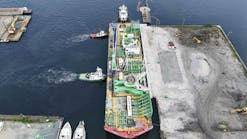Deepwater coupling effects: moderate for Spars, pronounced for FPSOs, not significant for TLPs
Still image from a computer animation of coupled analysis showing line breakage of FPSO mooring system.
New computational tools for the design and verification of deep water floating produc tion units have been developed by the Norwegian Marine Tech nology Research Institute (Marintek) and Det Norske Veritas (DNV) under the Deep Water Analysis Tools (DEEPER) joint industry project.
"From an industrial point of view, it's been a successful project," says Jørgen Krokstad, Marintek's project coordinator. "We were able to deliver just about everything we had planned for." DNV and Marintek will now set up a DEEPER user group, so that the participants can swap information on their experiences with the tools and possibly lay the basis for further refinements of them.
One important motive for the three-year project is the fact that offshore activities have moved into depths that cannot be properly simulated in model tests. Tests can provide acceptable verification at scales up to 1:150 - for modeling complete systems, with current. A maximum depth of 8-9 meters is available at Marintek's ocean basin, equivalent to around 1,350 meters.
It made sense to develop numerical tools which could be applied regardless of the water depth, Krokstad says. Some model testing was used during the project for verifying these tools. Separately, Marintek has worked on the development of hybrid modeling and testing in the VERIDEEP project.
The NKr 16 million DEEPER project was supported by five oil companies - Mobil, Norsk Hydro, Petrobras, Saga and Statoil - and several engineering and contracting companies - Aker Engineering, Babcock & Wilcox, Brown & Root, ETPM, Kv
- Increase accuracy in prediction/simulation of deep-water floating structures
- Extend current software capabilities
- Share costs in the development and maintenance of computer tools
- Offer a maintained and commercial software tool for the analysis of deepwater floating structures.
Four main subject areas were established:
- Deepwater mooring and floaters
- Deepwater marine risers
- Development of an integrated analysis tool - DEEPFLOATER
- Development of statistics and analysis procedures.
Focus on coupling
As the water depth increases, an increasing proportion of the cost of installing a floater goes into the mooring and risers. Increased current loads can also be expected, creating the potential for riser-to-riser collisions. An important focus was on the coupling effects between mooring and floater dynamics. It is customary to separate vessel and mooring analyses, Krokstad says, but in deepwater, the influence of the current on the vessel, mooring, and risers necessitates a simultaneous analysis of the complete system.
A screening of coupling effects was carried out to check whether it was possible to rely on more standard analyses only. Three water depth scenarios - moderate (500 meters), deep (1,000 meters) and ultra-deep (2,000 meters) were considered for TLPs, FPSOs, and spar platforms. The study concluded that coupling effects are pronounced for FPSO's in deepwater, while such effects are not substantial for deep-water TLPs. Spars had moderate coupled response in deepwater, but coupling effects could be high in ultra-deepwater.
Performing design and verification analysis for deepwater is much more involved from a numerical point of view than for shallow waters, Krokstad says - it is necessary to solve the complete system dynamics all at once. The situation is further complicated by the fact that less statistical data is generated because of the slower motions in deepwater, with the result that the reliability of the statistics is decreased.
The tools developed in the DEEPER project enable critical calculations to be made with respect to various phenomena which must be guarded against. One of these, for example, is ringing, which can be a hazard in terms of causing extreme loading on a structure. In deepwater, the natural period of heave increases to the point where the energy from steep waves causes high frequency loads.
The design must ensure high natural periods in the structure to cope with ringing. The issue came to prominence with the Heidrun TLP and the Draugen concrete gravity base platform, both of which were designed linearly. During testing, however, it was found that ringing would cause additional loads of 30-40%, which meant that parts of the platforms had to be redesigned, although construction of both platforms was already underway, Krokstad says.
Calculating VIV
Another critical calculation concerns the risers, which are mainly subject to current loads which can cause vortex induced vibration (VIV). VIV is normally considered a long-term fatigue problem, but it can also come into play during riser installation, when there is no pressure inside the riser, thus making it much more sensitive to forces in the external environment. Risers may break down during installation, due to VIV. A lot of experimental testing on VIV has been carried out at Marintek, and considerable experience has been gained, Krokstad says.
DEEPER's main computer deliverable is the DEEP FLOATER program, which consists of a number of core programs: SIMO (simulation of complex motion and operation), RIFLEX (riser or slender body analysis tool), and ADVANCE (a more general program for detailed structural riser analysis). A handbook of analysis procedures has also been produced.
Considerable efforts have been put into making the tools more user friendly. A graphical user interface (GUI) has been developed in order to reduce the burden of modelling and make it easier to identify errors. Marintek and DNV have cooperated on several recent joint industry projects in deepwater technology. It has been a fruitful collaboration, bringing research results directly into well proven commercial software products, Krokstad says.




